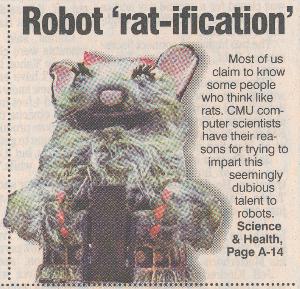
Robots are so rational, that's all there is to that! Their heads are full of silicon, wire and facts! They're nothing but exasperating, irritating, agonizing, calculating, agitating, maddening and infuriating racks! Why can't robots be more like a rat? A rat is so open, so easy to train; Eternally cheerful, historically sane. Who can run a maze and find its way without a silly spat. Why can't a robot be more like that? Why does every robot do only what you tell it to? Can't a robot learn to use its head? Why do they only do what their programs do? Why don't they adapt like a rodent instead? Why can't a robot take after a rat?
The part of Henry Higgins is being jointly played in this Carnegie Mellon University production by computer scientist David Touretzky and biopsychologist Lisa Saksida.
The role of Eliza Doolittle, the simple flower rat, is being played by everyone's favorite RWI B21 robot, Amelia.
Touretzky and Saksida do not regularly break into song in their Wean Hall laboratory, but they do hope to crack the code governing animal learning.
By programing a robot to think like a rat, they seek to accomplish at least two things: to develop a computational theory to explain the form of animal learning known as operant conditioning and to find a better way to train robots.
"Wouldn't it be great if you could train robots the way you train your dog?" said Touretzky, senior research scientist in Carnegie Mellon computer science department and Pittsburgh's Center for the Neural Basis of Cognition.
"Some animals can learn spectacularly," Touretzky said. Seeing-eye dogs and stunt-performing dolphins at Sea World are just two examples. "Certainly they can learn better than robots."

Robots and the computers that run them also perform amazing feats. But seldom can they easily adapt to changing environments or alterations in their tasks. Limits in their ability to learn also place limits on their applications.
Some work has been done using classical conditioning to train robots. Classical, or Pavlovian, conditioning involves teaching an animal to associate a stimulus with a reward or punishment, thus eliciting some behavioral response. If a bell is rung every time a dog is fed, for instance, a dog will eventually salivate at the sound of the bell, even if there is no food there.
As effective as classical conditioning may be, it doesn't help an animal -or a robot -adapt to changing circumstances. Salivating at the sound of a bell isn't very helpful if food isn't present. Operant or instrumental conditioning, by contrast, teaches an animal that obtaining a reward is a consequence of its behavior: A rat will learn to push a lever if doing so release food.
If a robot can be designed that can learn by by operant conditioning, it would let researchers find out what goes on inside the mind of a rat, or pigeon.
As a pyschology student, Lisa Saksida often worked with rats and pigeons to test theories of learning, but was unhappy with the results.
"In psychology we have some great theories, but they're at a high level," said Saksida, who is working on her doctorate in robotics. "It's hard to understand the exact mechanism."
For the past three years, Saksida and Touretzky have been developing computer programs for operant learning. Two years ago they began to test them using Amelia, a 4-foot-tall, drum-shaped robot. In recognition of the late psychologist B.F. Skinner's pioneering experiments in learning processes, they called the robot a "skinnerbot."
Amelia, the skinnerbot, can be outfitted with a gray-fur rat costume. She has a collar that flashes when she "talks" - a variety of electronic whistles and whines meant to reflect confusion, happiness, suprise and other mental states.
Using a vision system developed by undergraduate assistant Scott Raymond, she see through a video camera, and soon will have a laser range finder to help her move about without running into things.
Amelia's hardware, however, is a configuration developed by Carngie Mellon's Reid Simmons, and is fairly standard stuff around robotics labs. She is a descendant of Simmons' robot Xavier, which regularly roams Wean's hallways.
The unusual thing about Amelia is in her software: Something akin to pleasure is registered everytime onew of the researchers push a button on a remote control. When training Amelia, the button is used to reward the skinnerbot for a desired behavior.
For instance, one experiment is to teach Amelia to pick up toy dogs, placing pink toys in one box and placing green toys in another.
At first Amelia innately knows only that she can pick up toys and put them in boxes. She does this randomly, making noises indicating she doesn't know what is expected of her.
When she happens to put a green toy in a box designated for green toys, Saksida pushes the remote control. Amelia's electronic brain notes that something good has happened and Amelia issues a perky electronic chirp.
As the experiment continues, Amelia learns that placing a pink toy in the box for green toys earns her nothing. She registers disappointment that she did not receive the award she expected. Eventually, she learns that she can be reward for placing the pink toy in the box for pink toys.
Part of the research plan is to study how people interact with Amelia, Touretzky said. Do they suspend their disbelief and accept Amelia as some sort of intelligent being?
Does a rat costume, designed by drama professor Barbara Anderson, keep people from being intimidated by the task of programming a machine? The researchers may some day see whether giving Amelia might improve these interactions.
Changes are constantly being made to the software, as Touretzky and Saksida try to make the computer mimic the rat brain more precisely. Eventually, they hope to design software so that it mimics different parts of the brain, thus helping them pinpoint which parts of the brain are involved in different aspects of learning.
Touretzky said that they also hope to give Amelia finer control over her hand movements. As she becomes more sophisticated in what she can do, her learning functions also must change. An undergraduate assistant David Tolliver, is developing more sophisticated sound effects for Amelia.
But Amelia will continue to get only positive feedback. Punishment is not a good training tool, Touretzky said, because it agitates the animal- and persumibly the skinnerbot -making it to concentrate on learning.
"If you read animal-trainer books - which I've been doing a lot lately - you see the good animal trainers say to reward animals, not punish them."